Requirement Elicitation Techniques Report for CBRE3103 Course
VerifiedAdded on 2023/01/10
|12
|2823
|39
Report
AI Summary
This report delves into the realm of requirement elicitation techniques, a critical aspect of requirement engineering. It begins by emphasizing the importance of understanding the system context to be developed and then explores different types of requirement sources. The report differentiates the roles of requirement engineers and stakeholders during the elicitation process, highlighting their respective responsibilities. Subsequently, it discusses various techniques employed in requirement elicitation, including surveys, creative approaches, document-centric methods, observation techniques, and support systems. The report provides a comprehensive overview of each technique, detailing their applications and significance in gathering and analyzing requirements for a system. The discussion covers the advantages, disadvantages, and practical implementations of each technique, offering a well-rounded understanding of how to effectively elicit requirements in diverse project scenarios.
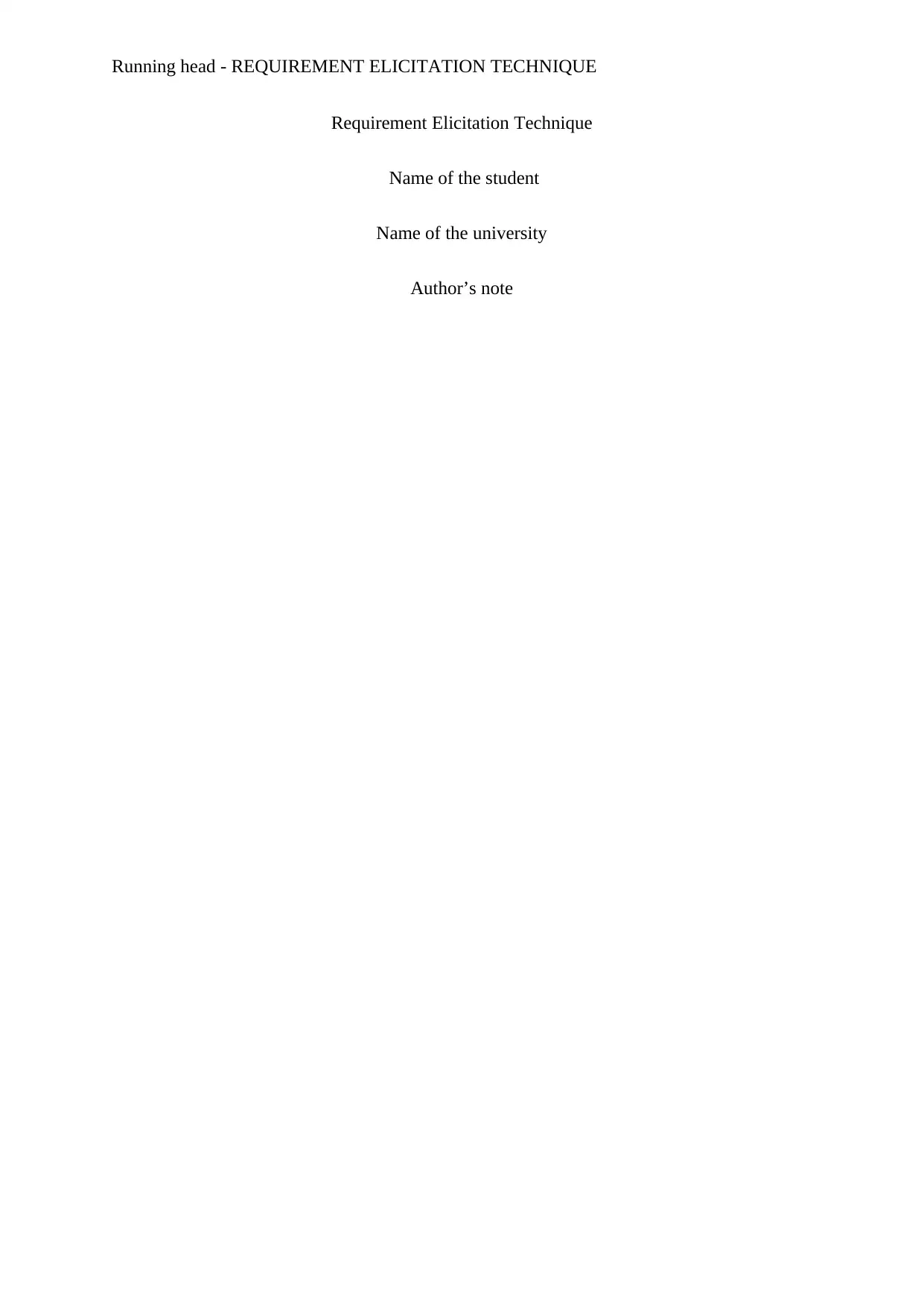
Running head - REQUIREMENT ELICITATION TECHNIQUE
Requirement Elicitation Technique
Name of the student
Name of the university
Author’s note
Requirement Elicitation Technique
Name of the student
Name of the university
Author’s note
Paraphrase This Document
Need a fresh take? Get an instant paraphrase of this document with our AI Paraphraser
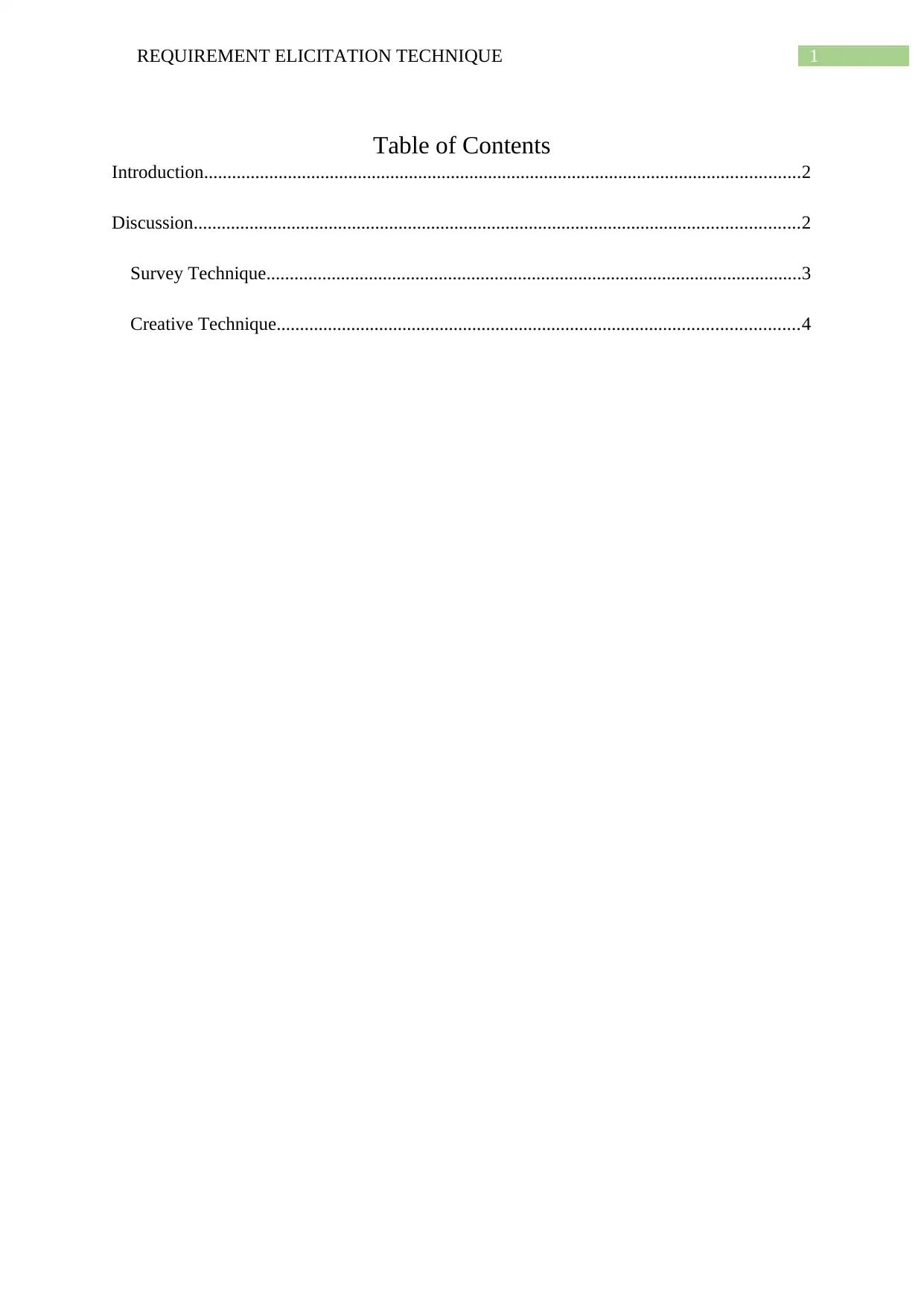
1REQUIREMENT ELICITATION TECHNIQUE
Table of Contents
Introduction................................................................................................................................2
Discussion..................................................................................................................................2
Survey Technique...................................................................................................................3
Creative Technique................................................................................................................4
Table of Contents
Introduction................................................................................................................................2
Discussion..................................................................................................................................2
Survey Technique...................................................................................................................3
Creative Technique................................................................................................................4
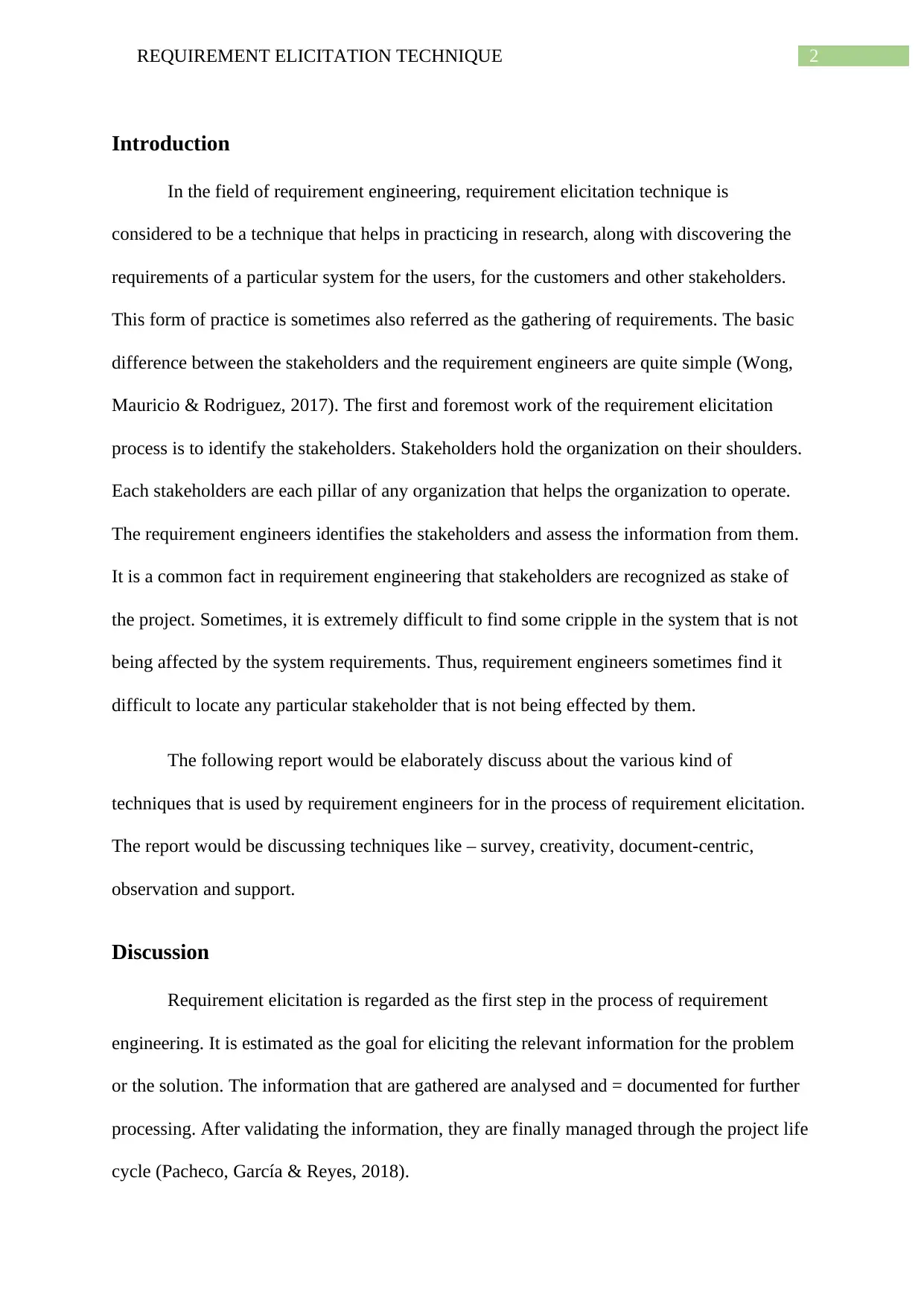
2REQUIREMENT ELICITATION TECHNIQUE
Introduction
In the field of requirement engineering, requirement elicitation technique is
considered to be a technique that helps in practicing in research, along with discovering the
requirements of a particular system for the users, for the customers and other stakeholders.
This form of practice is sometimes also referred as the gathering of requirements. The basic
difference between the stakeholders and the requirement engineers are quite simple (Wong,
Mauricio & Rodriguez, 2017). The first and foremost work of the requirement elicitation
process is to identify the stakeholders. Stakeholders hold the organization on their shoulders.
Each stakeholders are each pillar of any organization that helps the organization to operate.
The requirement engineers identifies the stakeholders and assess the information from them.
It is a common fact in requirement engineering that stakeholders are recognized as stake of
the project. Sometimes, it is extremely difficult to find some cripple in the system that is not
being affected by the system requirements. Thus, requirement engineers sometimes find it
difficult to locate any particular stakeholder that is not being effected by them.
The following report would be elaborately discuss about the various kind of
techniques that is used by requirement engineers for in the process of requirement elicitation.
The report would be discussing techniques like – survey, creativity, document-centric,
observation and support.
Discussion
Requirement elicitation is regarded as the first step in the process of requirement
engineering. It is estimated as the goal for eliciting the relevant information for the problem
or the solution. The information that are gathered are analysed and = documented for further
processing. After validating the information, they are finally managed through the project life
cycle (Pacheco, García & Reyes, 2018).
Introduction
In the field of requirement engineering, requirement elicitation technique is
considered to be a technique that helps in practicing in research, along with discovering the
requirements of a particular system for the users, for the customers and other stakeholders.
This form of practice is sometimes also referred as the gathering of requirements. The basic
difference between the stakeholders and the requirement engineers are quite simple (Wong,
Mauricio & Rodriguez, 2017). The first and foremost work of the requirement elicitation
process is to identify the stakeholders. Stakeholders hold the organization on their shoulders.
Each stakeholders are each pillar of any organization that helps the organization to operate.
The requirement engineers identifies the stakeholders and assess the information from them.
It is a common fact in requirement engineering that stakeholders are recognized as stake of
the project. Sometimes, it is extremely difficult to find some cripple in the system that is not
being affected by the system requirements. Thus, requirement engineers sometimes find it
difficult to locate any particular stakeholder that is not being effected by them.
The following report would be elaborately discuss about the various kind of
techniques that is used by requirement engineers for in the process of requirement elicitation.
The report would be discussing techniques like – survey, creativity, document-centric,
observation and support.
Discussion
Requirement elicitation is regarded as the first step in the process of requirement
engineering. It is estimated as the goal for eliciting the relevant information for the problem
or the solution. The information that are gathered are analysed and = documented for further
processing. After validating the information, they are finally managed through the project life
cycle (Pacheco, García & Reyes, 2018).
⊘ This is a preview!⊘
Do you want full access?
Subscribe today to unlock all pages.

Trusted by 1+ million students worldwide
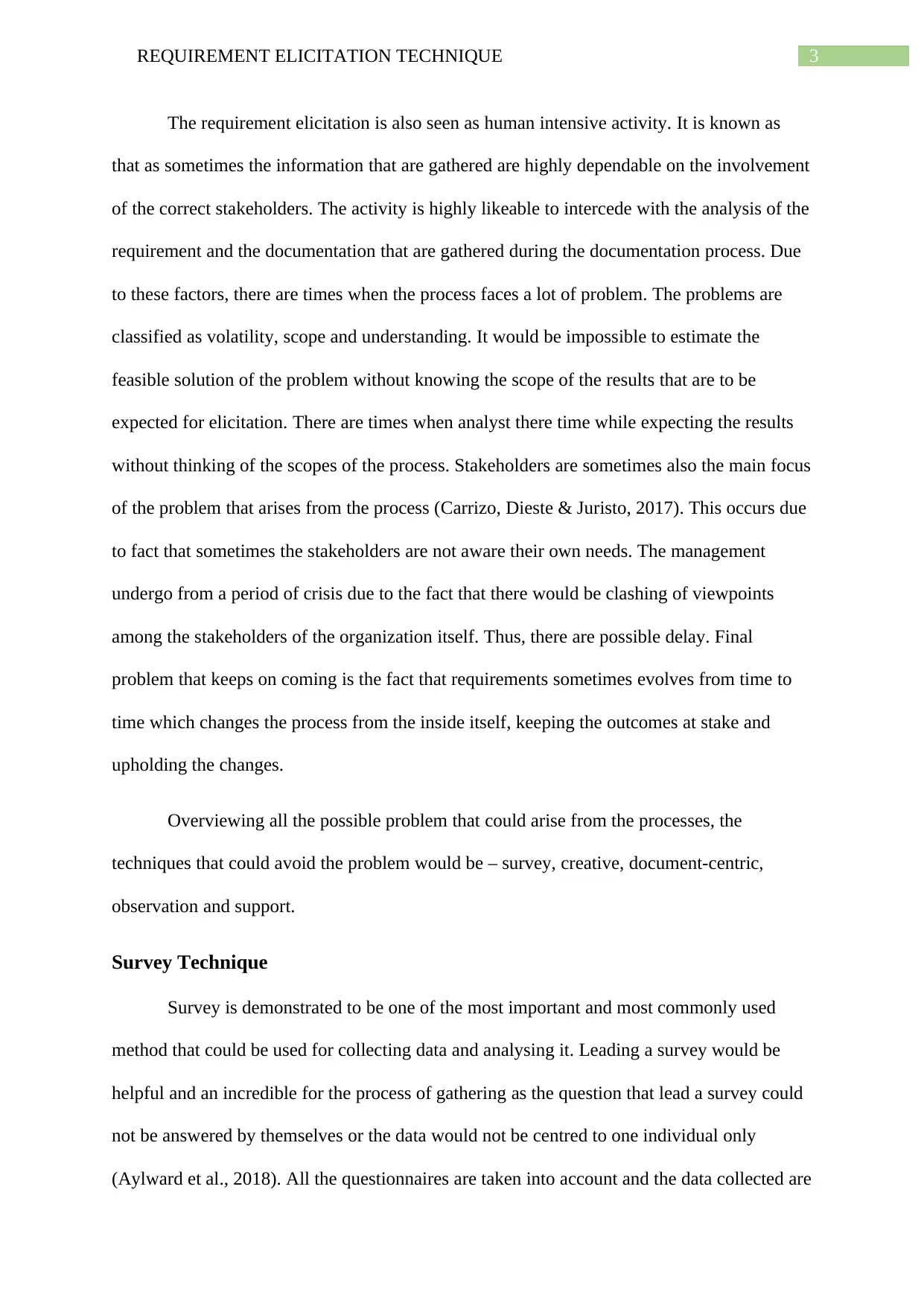
3REQUIREMENT ELICITATION TECHNIQUE
The requirement elicitation is also seen as human intensive activity. It is known as
that as sometimes the information that are gathered are highly dependable on the involvement
of the correct stakeholders. The activity is highly likeable to intercede with the analysis of the
requirement and the documentation that are gathered during the documentation process. Due
to these factors, there are times when the process faces a lot of problem. The problems are
classified as volatility, scope and understanding. It would be impossible to estimate the
feasible solution of the problem without knowing the scope of the results that are to be
expected for elicitation. There are times when analyst there time while expecting the results
without thinking of the scopes of the process. Stakeholders are sometimes also the main focus
of the problem that arises from the process (Carrizo, Dieste & Juristo, 2017). This occurs due
to fact that sometimes the stakeholders are not aware their own needs. The management
undergo from a period of crisis due to the fact that there would be clashing of viewpoints
among the stakeholders of the organization itself. Thus, there are possible delay. Final
problem that keeps on coming is the fact that requirements sometimes evolves from time to
time which changes the process from the inside itself, keeping the outcomes at stake and
upholding the changes.
Overviewing all the possible problem that could arise from the processes, the
techniques that could avoid the problem would be – survey, creative, document-centric,
observation and support.
Survey Technique
Survey is demonstrated to be one of the most important and most commonly used
method that could be used for collecting data and analysing it. Leading a survey would be
helpful and an incredible for the process of gathering as the question that lead a survey could
not be answered by themselves or the data would not be centred to one individual only
(Aylward et al., 2018). All the questionnaires are taken into account and the data collected are
The requirement elicitation is also seen as human intensive activity. It is known as
that as sometimes the information that are gathered are highly dependable on the involvement
of the correct stakeholders. The activity is highly likeable to intercede with the analysis of the
requirement and the documentation that are gathered during the documentation process. Due
to these factors, there are times when the process faces a lot of problem. The problems are
classified as volatility, scope and understanding. It would be impossible to estimate the
feasible solution of the problem without knowing the scope of the results that are to be
expected for elicitation. There are times when analyst there time while expecting the results
without thinking of the scopes of the process. Stakeholders are sometimes also the main focus
of the problem that arises from the process (Carrizo, Dieste & Juristo, 2017). This occurs due
to fact that sometimes the stakeholders are not aware their own needs. The management
undergo from a period of crisis due to the fact that there would be clashing of viewpoints
among the stakeholders of the organization itself. Thus, there are possible delay. Final
problem that keeps on coming is the fact that requirements sometimes evolves from time to
time which changes the process from the inside itself, keeping the outcomes at stake and
upholding the changes.
Overviewing all the possible problem that could arise from the processes, the
techniques that could avoid the problem would be – survey, creative, document-centric,
observation and support.
Survey Technique
Survey is demonstrated to be one of the most important and most commonly used
method that could be used for collecting data and analysing it. Leading a survey would be
helpful and an incredible for the process of gathering as the question that lead a survey could
not be answered by themselves or the data would not be centred to one individual only
(Aylward et al., 2018). All the questionnaires are taken into account and the data collected are
Paraphrase This Document
Need a fresh take? Get an instant paraphrase of this document with our AI Paraphraser
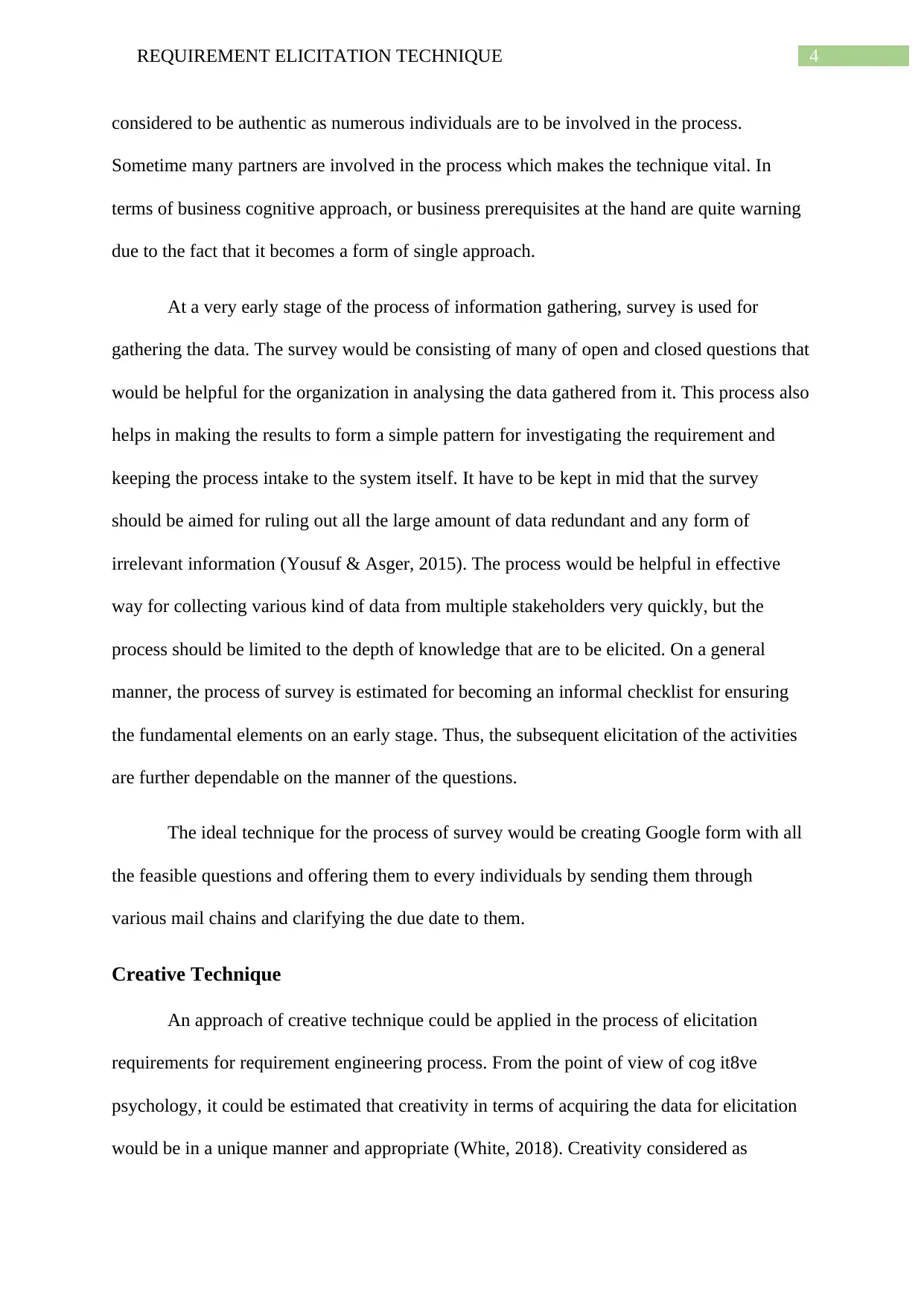
4REQUIREMENT ELICITATION TECHNIQUE
considered to be authentic as numerous individuals are to be involved in the process.
Sometime many partners are involved in the process which makes the technique vital. In
terms of business cognitive approach, or business prerequisites at the hand are quite warning
due to the fact that it becomes a form of single approach.
At a very early stage of the process of information gathering, survey is used for
gathering the data. The survey would be consisting of many of open and closed questions that
would be helpful for the organization in analysing the data gathered from it. This process also
helps in making the results to form a simple pattern for investigating the requirement and
keeping the process intake to the system itself. It have to be kept in mid that the survey
should be aimed for ruling out all the large amount of data redundant and any form of
irrelevant information (Yousuf & Asger, 2015). The process would be helpful in effective
way for collecting various kind of data from multiple stakeholders very quickly, but the
process should be limited to the depth of knowledge that are to be elicited. On a general
manner, the process of survey is estimated for becoming an informal checklist for ensuring
the fundamental elements on an early stage. Thus, the subsequent elicitation of the activities
are further dependable on the manner of the questions.
The ideal technique for the process of survey would be creating Google form with all
the feasible questions and offering them to every individuals by sending them through
various mail chains and clarifying the due date to them.
Creative Technique
An approach of creative technique could be applied in the process of elicitation
requirements for requirement engineering process. From the point of view of cog it8ve
psychology, it could be estimated that creativity in terms of acquiring the data for elicitation
would be in a unique manner and appropriate (White, 2018). Creativity considered as
considered to be authentic as numerous individuals are to be involved in the process.
Sometime many partners are involved in the process which makes the technique vital. In
terms of business cognitive approach, or business prerequisites at the hand are quite warning
due to the fact that it becomes a form of single approach.
At a very early stage of the process of information gathering, survey is used for
gathering the data. The survey would be consisting of many of open and closed questions that
would be helpful for the organization in analysing the data gathered from it. This process also
helps in making the results to form a simple pattern for investigating the requirement and
keeping the process intake to the system itself. It have to be kept in mid that the survey
should be aimed for ruling out all the large amount of data redundant and any form of
irrelevant information (Yousuf & Asger, 2015). The process would be helpful in effective
way for collecting various kind of data from multiple stakeholders very quickly, but the
process should be limited to the depth of knowledge that are to be elicited. On a general
manner, the process of survey is estimated for becoming an informal checklist for ensuring
the fundamental elements on an early stage. Thus, the subsequent elicitation of the activities
are further dependable on the manner of the questions.
The ideal technique for the process of survey would be creating Google form with all
the feasible questions and offering them to every individuals by sending them through
various mail chains and clarifying the due date to them.
Creative Technique
An approach of creative technique could be applied in the process of elicitation
requirements for requirement engineering process. From the point of view of cog it8ve
psychology, it could be estimated that creativity in terms of acquiring the data for elicitation
would be in a unique manner and appropriate (White, 2018). Creativity considered as
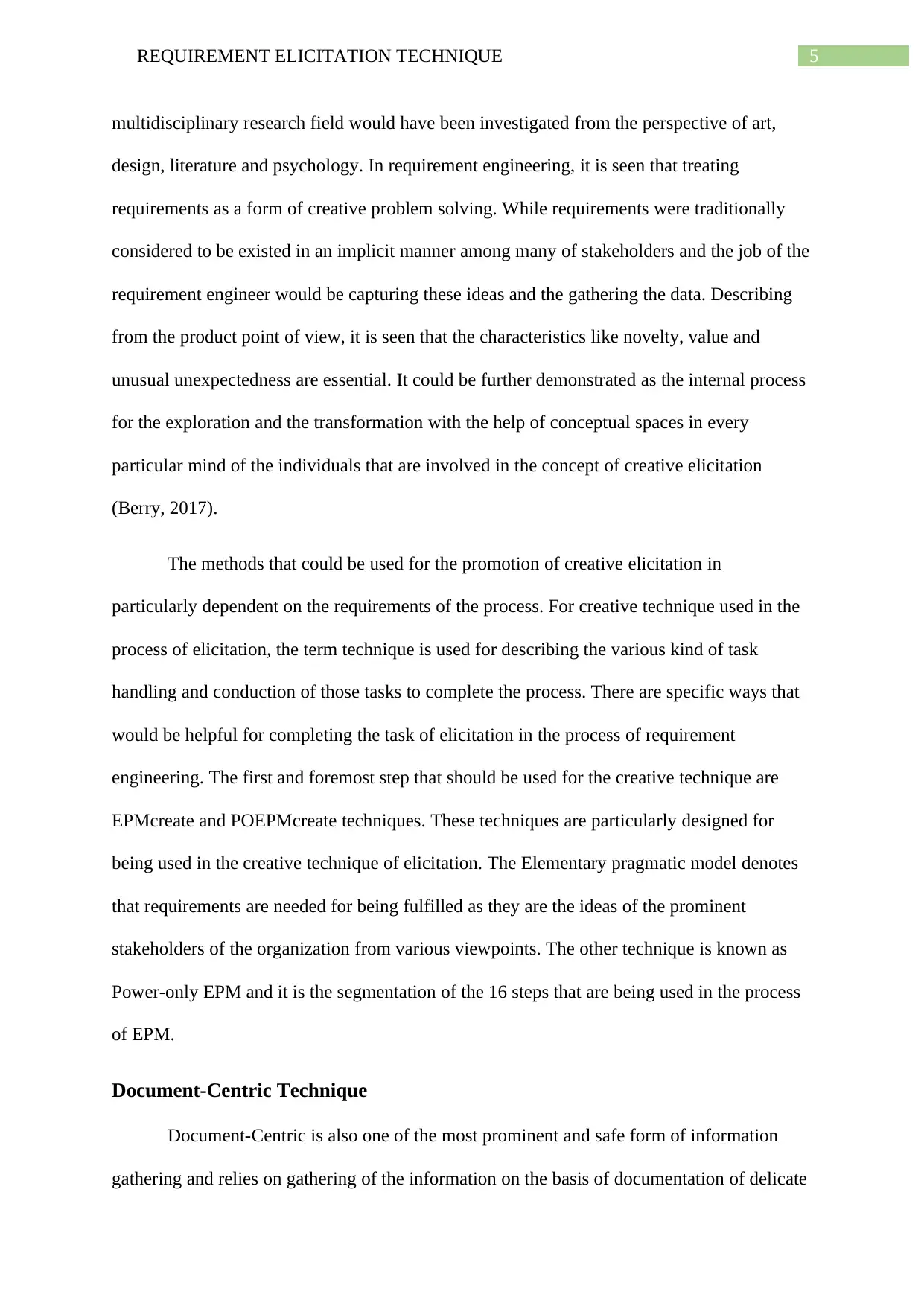
5REQUIREMENT ELICITATION TECHNIQUE
multidisciplinary research field would have been investigated from the perspective of art,
design, literature and psychology. In requirement engineering, it is seen that treating
requirements as a form of creative problem solving. While requirements were traditionally
considered to be existed in an implicit manner among many of stakeholders and the job of the
requirement engineer would be capturing these ideas and the gathering the data. Describing
from the product point of view, it is seen that the characteristics like novelty, value and
unusual unexpectedness are essential. It could be further demonstrated as the internal process
for the exploration and the transformation with the help of conceptual spaces in every
particular mind of the individuals that are involved in the concept of creative elicitation
(Berry, 2017).
The methods that could be used for the promotion of creative elicitation in
particularly dependent on the requirements of the process. For creative technique used in the
process of elicitation, the term technique is used for describing the various kind of task
handling and conduction of those tasks to complete the process. There are specific ways that
would be helpful for completing the task of elicitation in the process of requirement
engineering. The first and foremost step that should be used for the creative technique are
EPMcreate and POEPMcreate techniques. These techniques are particularly designed for
being used in the creative technique of elicitation. The Elementary pragmatic model denotes
that requirements are needed for being fulfilled as they are the ideas of the prominent
stakeholders of the organization from various viewpoints. The other technique is known as
Power-only EPM and it is the segmentation of the 16 steps that are being used in the process
of EPM.
Document-Centric Technique
Document-Centric is also one of the most prominent and safe form of information
gathering and relies on gathering of the information on the basis of documentation of delicate
multidisciplinary research field would have been investigated from the perspective of art,
design, literature and psychology. In requirement engineering, it is seen that treating
requirements as a form of creative problem solving. While requirements were traditionally
considered to be existed in an implicit manner among many of stakeholders and the job of the
requirement engineer would be capturing these ideas and the gathering the data. Describing
from the product point of view, it is seen that the characteristics like novelty, value and
unusual unexpectedness are essential. It could be further demonstrated as the internal process
for the exploration and the transformation with the help of conceptual spaces in every
particular mind of the individuals that are involved in the concept of creative elicitation
(Berry, 2017).
The methods that could be used for the promotion of creative elicitation in
particularly dependent on the requirements of the process. For creative technique used in the
process of elicitation, the term technique is used for describing the various kind of task
handling and conduction of those tasks to complete the process. There are specific ways that
would be helpful for completing the task of elicitation in the process of requirement
engineering. The first and foremost step that should be used for the creative technique are
EPMcreate and POEPMcreate techniques. These techniques are particularly designed for
being used in the creative technique of elicitation. The Elementary pragmatic model denotes
that requirements are needed for being fulfilled as they are the ideas of the prominent
stakeholders of the organization from various viewpoints. The other technique is known as
Power-only EPM and it is the segmentation of the 16 steps that are being used in the process
of EPM.
Document-Centric Technique
Document-Centric is also one of the most prominent and safe form of information
gathering and relies on gathering of the information on the basis of documentation of delicate
⊘ This is a preview!⊘
Do you want full access?
Subscribe today to unlock all pages.

Trusted by 1+ million students worldwide
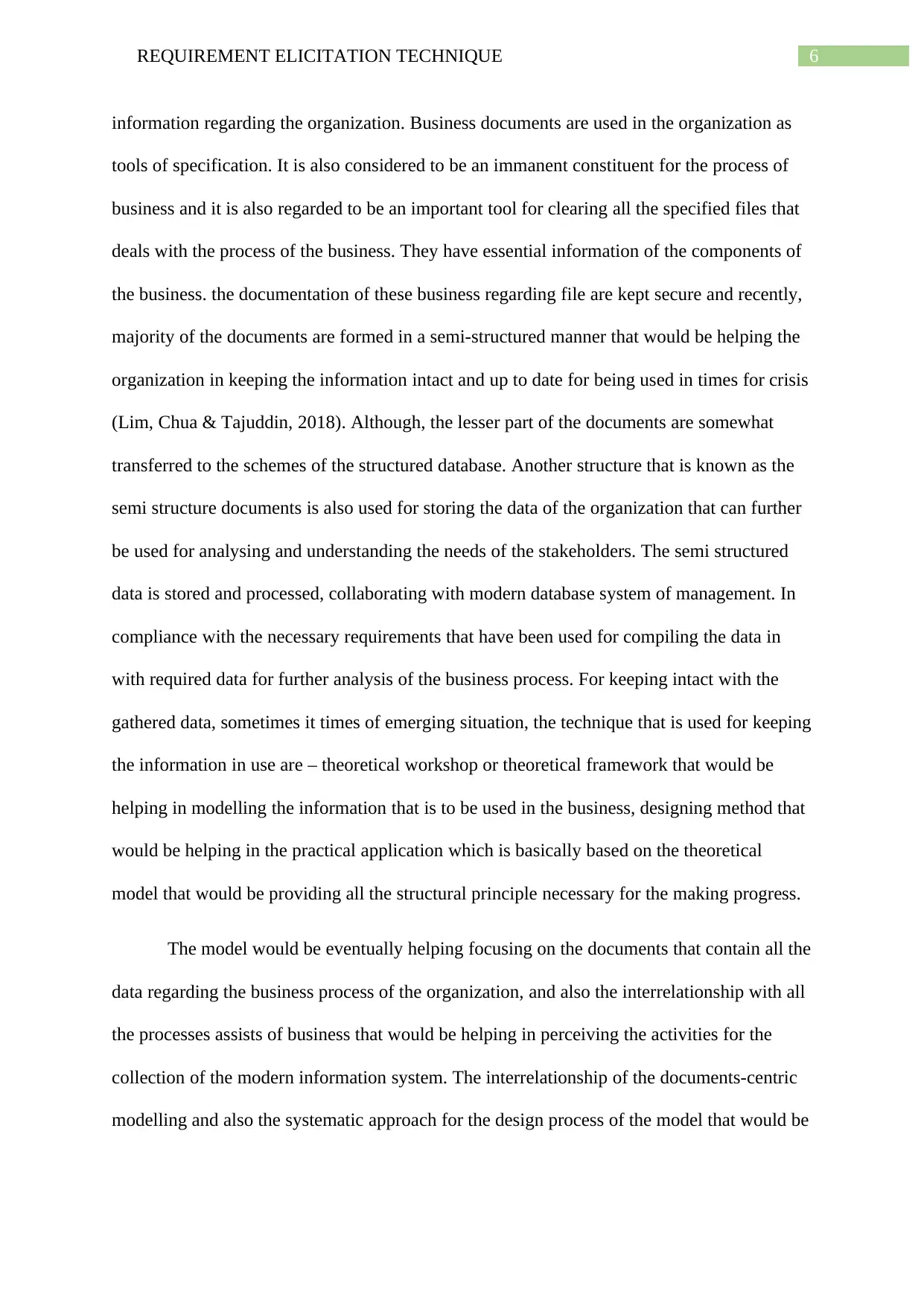
6REQUIREMENT ELICITATION TECHNIQUE
information regarding the organization. Business documents are used in the organization as
tools of specification. It is also considered to be an immanent constituent for the process of
business and it is also regarded to be an important tool for clearing all the specified files that
deals with the process of the business. They have essential information of the components of
the business. the documentation of these business regarding file are kept secure and recently,
majority of the documents are formed in a semi-structured manner that would be helping the
organization in keeping the information intact and up to date for being used in times for crisis
(Lim, Chua & Tajuddin, 2018). Although, the lesser part of the documents are somewhat
transferred to the schemes of the structured database. Another structure that is known as the
semi structure documents is also used for storing the data of the organization that can further
be used for analysing and understanding the needs of the stakeholders. The semi structured
data is stored and processed, collaborating with modern database system of management. In
compliance with the necessary requirements that have been used for compiling the data in
with required data for further analysis of the business process. For keeping intact with the
gathered data, sometimes it times of emerging situation, the technique that is used for keeping
the information in use are – theoretical workshop or theoretical framework that would be
helping in modelling the information that is to be used in the business, designing method that
would be helping in the practical application which is basically based on the theoretical
model that would be providing all the structural principle necessary for the making progress.
The model would be eventually helping focusing on the documents that contain all the
data regarding the business process of the organization, and also the interrelationship with all
the processes assists of business that would be helping in perceiving the activities for the
collection of the modern information system. The interrelationship of the documents-centric
modelling and also the systematic approach for the design process of the model that would be
information regarding the organization. Business documents are used in the organization as
tools of specification. It is also considered to be an immanent constituent for the process of
business and it is also regarded to be an important tool for clearing all the specified files that
deals with the process of the business. They have essential information of the components of
the business. the documentation of these business regarding file are kept secure and recently,
majority of the documents are formed in a semi-structured manner that would be helping the
organization in keeping the information intact and up to date for being used in times for crisis
(Lim, Chua & Tajuddin, 2018). Although, the lesser part of the documents are somewhat
transferred to the schemes of the structured database. Another structure that is known as the
semi structure documents is also used for storing the data of the organization that can further
be used for analysing and understanding the needs of the stakeholders. The semi structured
data is stored and processed, collaborating with modern database system of management. In
compliance with the necessary requirements that have been used for compiling the data in
with required data for further analysis of the business process. For keeping intact with the
gathered data, sometimes it times of emerging situation, the technique that is used for keeping
the information in use are – theoretical workshop or theoretical framework that would be
helping in modelling the information that is to be used in the business, designing method that
would be helping in the practical application which is basically based on the theoretical
model that would be providing all the structural principle necessary for the making progress.
The model would be eventually helping focusing on the documents that contain all the
data regarding the business process of the organization, and also the interrelationship with all
the processes assists of business that would be helping in perceiving the activities for the
collection of the modern information system. The interrelationship of the documents-centric
modelling and also the systematic approach for the design process of the model that would be
Paraphrase This Document
Need a fresh take? Get an instant paraphrase of this document with our AI Paraphraser
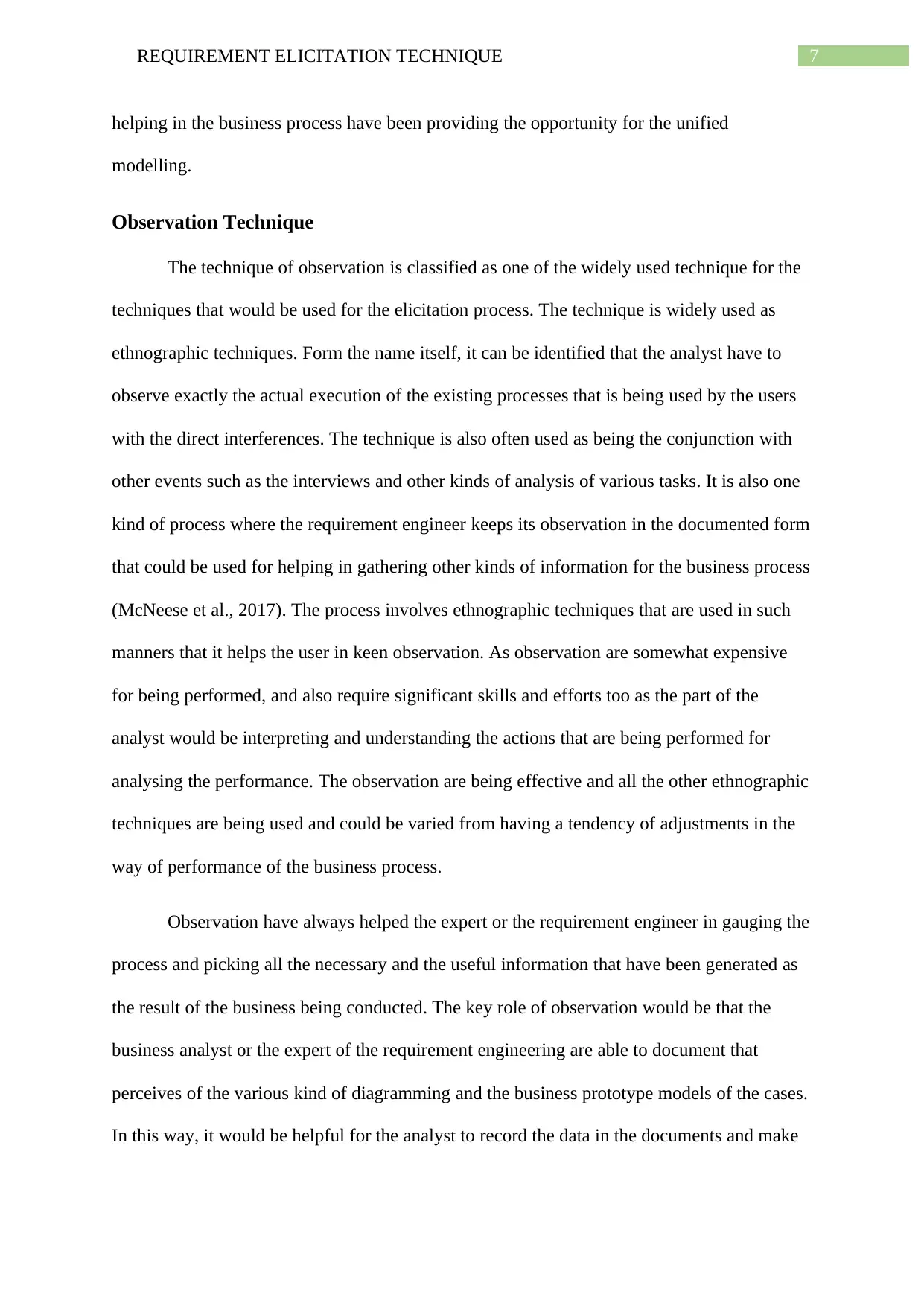
7REQUIREMENT ELICITATION TECHNIQUE
helping in the business process have been providing the opportunity for the unified
modelling.
Observation Technique
The technique of observation is classified as one of the widely used technique for the
techniques that would be used for the elicitation process. The technique is widely used as
ethnographic techniques. Form the name itself, it can be identified that the analyst have to
observe exactly the actual execution of the existing processes that is being used by the users
with the direct interferences. The technique is also often used as being the conjunction with
other events such as the interviews and other kinds of analysis of various tasks. It is also one
kind of process where the requirement engineer keeps its observation in the documented form
that could be used for helping in gathering other kinds of information for the business process
(McNeese et al., 2017). The process involves ethnographic techniques that are used in such
manners that it helps the user in keen observation. As observation are somewhat expensive
for being performed, and also require significant skills and efforts too as the part of the
analyst would be interpreting and understanding the actions that are being performed for
analysing the performance. The observation are being effective and all the other ethnographic
techniques are being used and could be varied from having a tendency of adjustments in the
way of performance of the business process.
Observation have always helped the expert or the requirement engineer in gauging the
process and picking all the necessary and the useful information that have been generated as
the result of the business being conducted. The key role of observation would be that the
business analyst or the expert of the requirement engineering are able to document that
perceives of the various kind of diagramming and the business prototype models of the cases.
In this way, it would be helpful for the analyst to record the data in the documents and make
helping in the business process have been providing the opportunity for the unified
modelling.
Observation Technique
The technique of observation is classified as one of the widely used technique for the
techniques that would be used for the elicitation process. The technique is widely used as
ethnographic techniques. Form the name itself, it can be identified that the analyst have to
observe exactly the actual execution of the existing processes that is being used by the users
with the direct interferences. The technique is also often used as being the conjunction with
other events such as the interviews and other kinds of analysis of various tasks. It is also one
kind of process where the requirement engineer keeps its observation in the documented form
that could be used for helping in gathering other kinds of information for the business process
(McNeese et al., 2017). The process involves ethnographic techniques that are used in such
manners that it helps the user in keen observation. As observation are somewhat expensive
for being performed, and also require significant skills and efforts too as the part of the
analyst would be interpreting and understanding the actions that are being performed for
analysing the performance. The observation are being effective and all the other ethnographic
techniques are being used and could be varied from having a tendency of adjustments in the
way of performance of the business process.
Observation have always helped the expert or the requirement engineer in gauging the
process and picking all the necessary and the useful information that have been generated as
the result of the business being conducted. The key role of observation would be that the
business analyst or the expert of the requirement engineering are able to document that
perceives of the various kind of diagramming and the business prototype models of the cases.
In this way, it would be helpful for the analyst to record the data in the documents and make
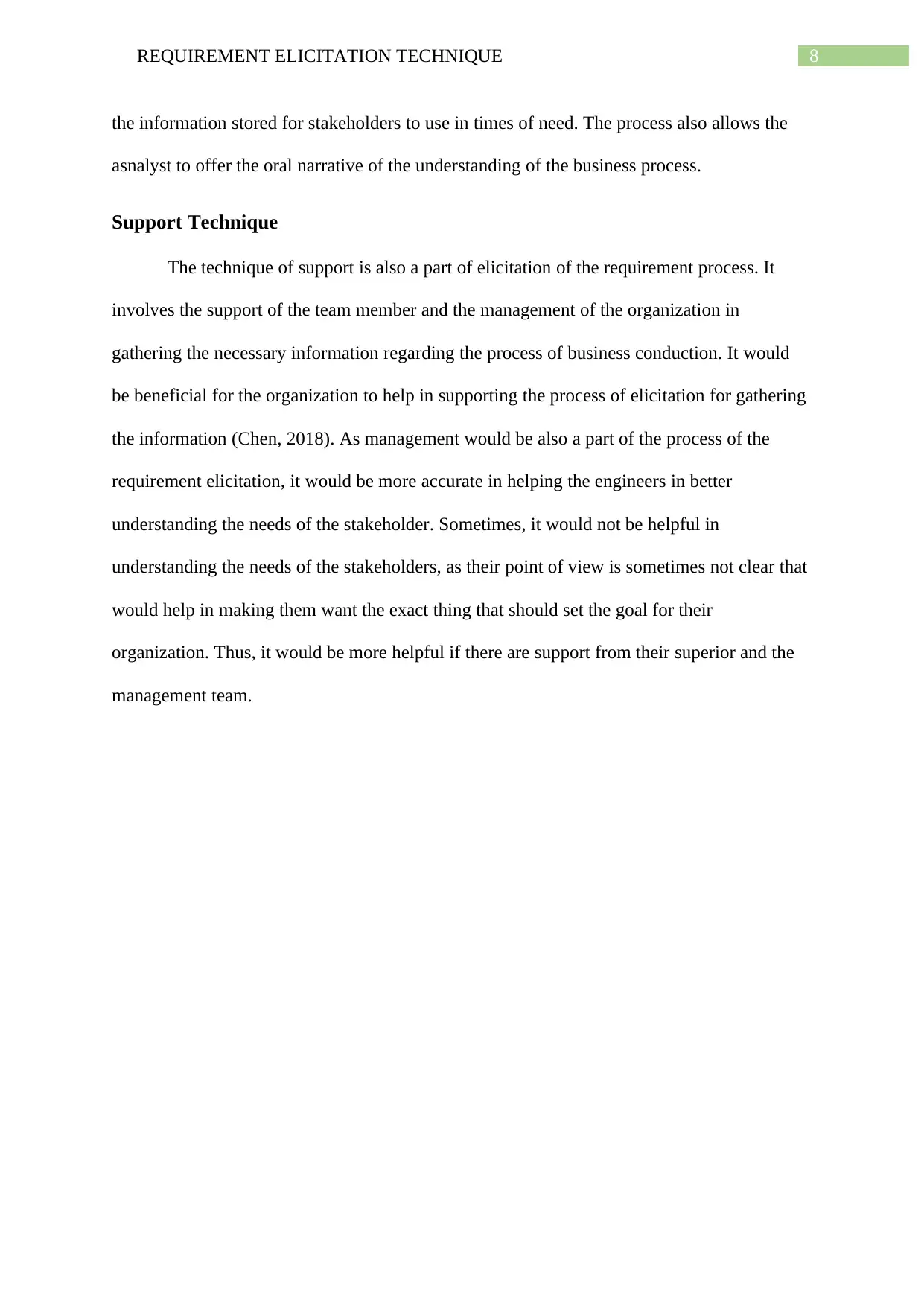
8REQUIREMENT ELICITATION TECHNIQUE
the information stored for stakeholders to use in times of need. The process also allows the
asnalyst to offer the oral narrative of the understanding of the business process.
Support Technique
The technique of support is also a part of elicitation of the requirement process. It
involves the support of the team member and the management of the organization in
gathering the necessary information regarding the process of business conduction. It would
be beneficial for the organization to help in supporting the process of elicitation for gathering
the information (Chen, 2018). As management would be also a part of the process of the
requirement elicitation, it would be more accurate in helping the engineers in better
understanding the needs of the stakeholder. Sometimes, it would not be helpful in
understanding the needs of the stakeholders, as their point of view is sometimes not clear that
would help in making them want the exact thing that should set the goal for their
organization. Thus, it would be more helpful if there are support from their superior and the
management team.
the information stored for stakeholders to use in times of need. The process also allows the
asnalyst to offer the oral narrative of the understanding of the business process.
Support Technique
The technique of support is also a part of elicitation of the requirement process. It
involves the support of the team member and the management of the organization in
gathering the necessary information regarding the process of business conduction. It would
be beneficial for the organization to help in supporting the process of elicitation for gathering
the information (Chen, 2018). As management would be also a part of the process of the
requirement elicitation, it would be more accurate in helping the engineers in better
understanding the needs of the stakeholder. Sometimes, it would not be helpful in
understanding the needs of the stakeholders, as their point of view is sometimes not clear that
would help in making them want the exact thing that should set the goal for their
organization. Thus, it would be more helpful if there are support from their superior and the
management team.
⊘ This is a preview!⊘
Do you want full access?
Subscribe today to unlock all pages.

Trusted by 1+ million students worldwide
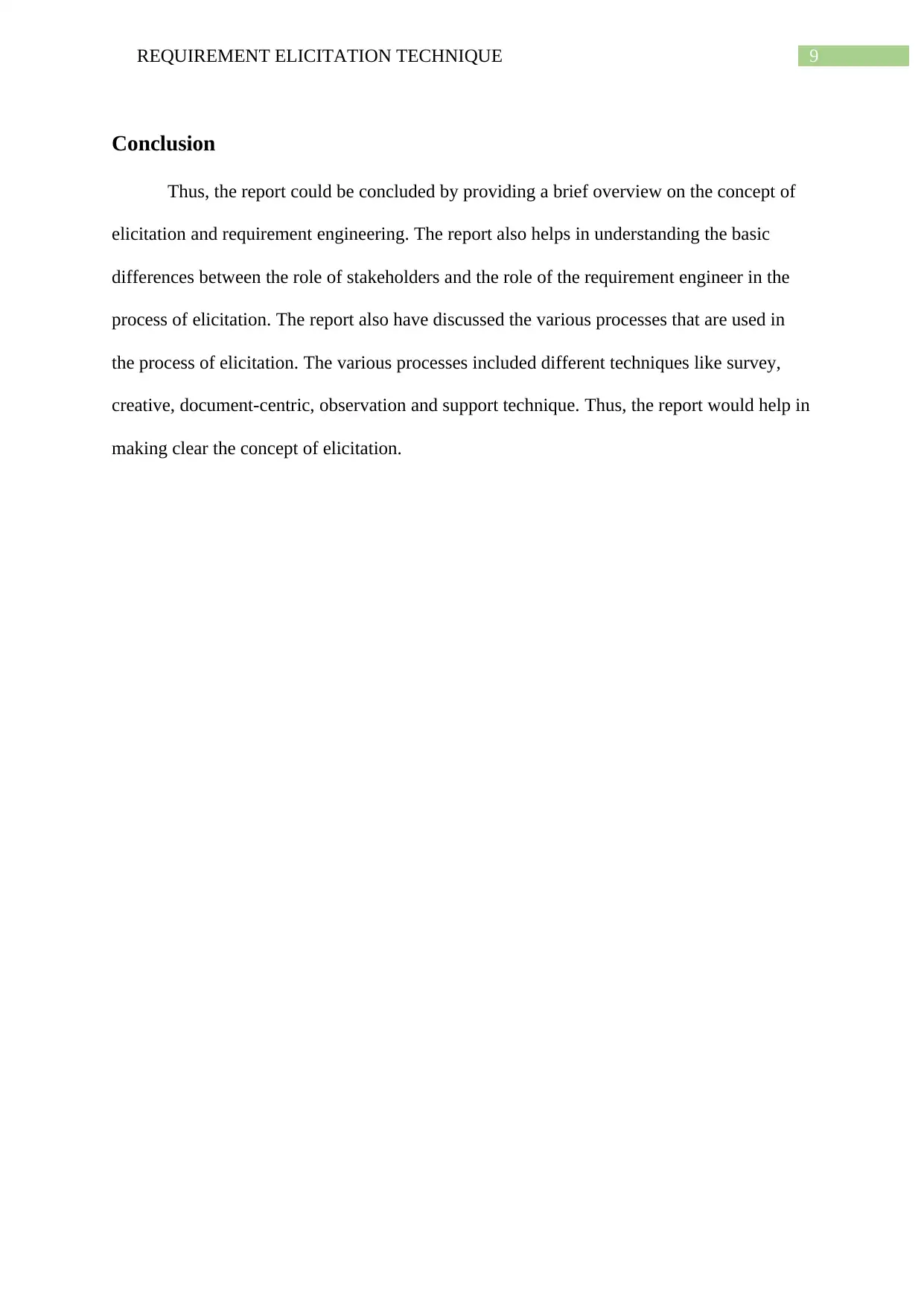
9REQUIREMENT ELICITATION TECHNIQUE
Conclusion
Thus, the report could be concluded by providing a brief overview on the concept of
elicitation and requirement engineering. The report also helps in understanding the basic
differences between the role of stakeholders and the role of the requirement engineer in the
process of elicitation. The report also have discussed the various processes that are used in
the process of elicitation. The various processes included different techniques like survey,
creative, document-centric, observation and support technique. Thus, the report would help in
making clear the concept of elicitation.
Conclusion
Thus, the report could be concluded by providing a brief overview on the concept of
elicitation and requirement engineering. The report also helps in understanding the basic
differences between the role of stakeholders and the role of the requirement engineer in the
process of elicitation. The report also have discussed the various processes that are used in
the process of elicitation. The various processes included different techniques like survey,
creative, document-centric, observation and support technique. Thus, the report would help in
making clear the concept of elicitation.
Paraphrase This Document
Need a fresh take? Get an instant paraphrase of this document with our AI Paraphraser
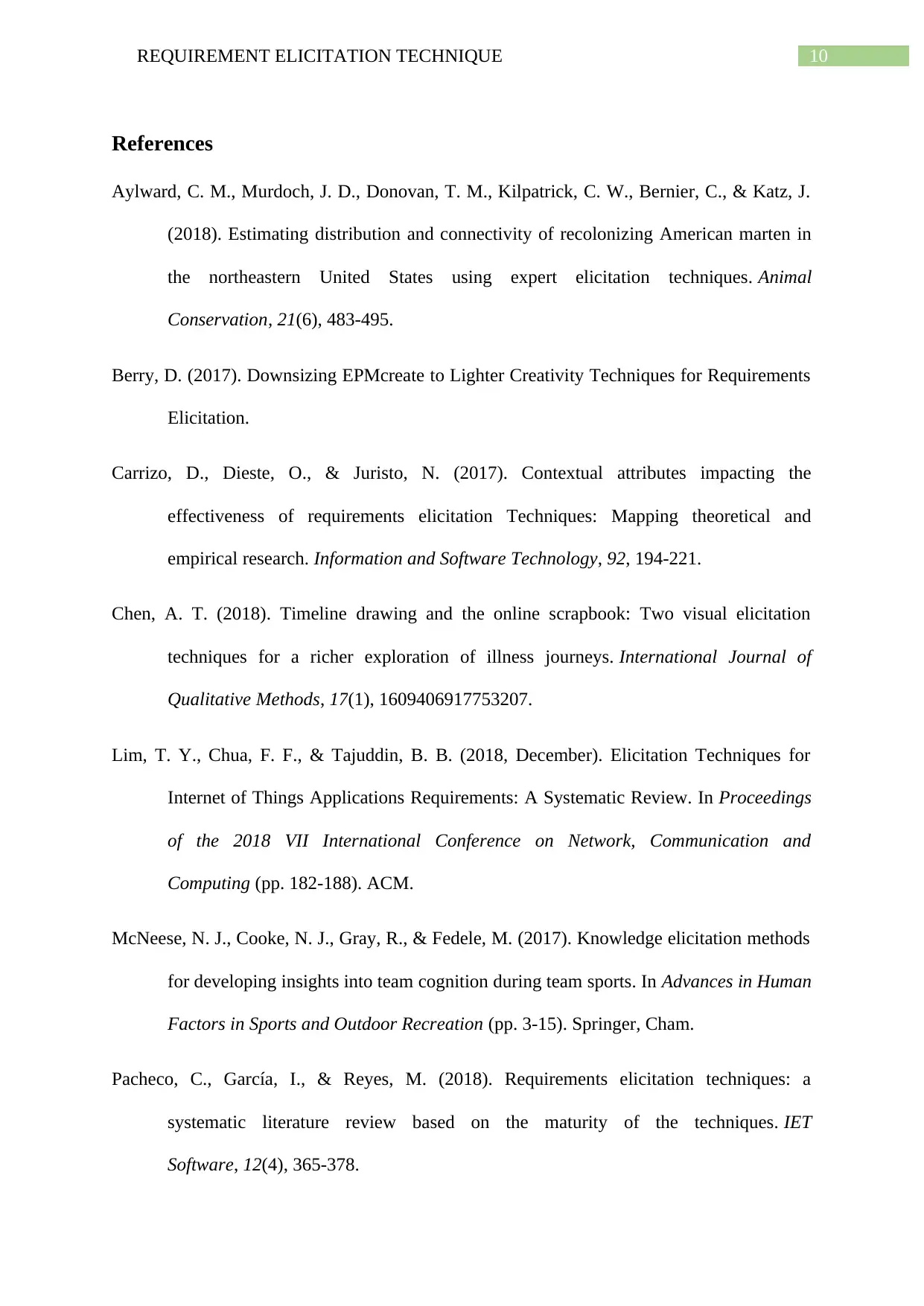
10REQUIREMENT ELICITATION TECHNIQUE
References
Aylward, C. M., Murdoch, J. D., Donovan, T. M., Kilpatrick, C. W., Bernier, C., & Katz, J.
(2018). Estimating distribution and connectivity of recolonizing American marten in
the northeastern United States using expert elicitation techniques. Animal
Conservation, 21(6), 483-495.
Berry, D. (2017). Downsizing EPMcreate to Lighter Creativity Techniques for Requirements
Elicitation.
Carrizo, D., Dieste, O., & Juristo, N. (2017). Contextual attributes impacting the
effectiveness of requirements elicitation Techniques: Mapping theoretical and
empirical research. Information and Software Technology, 92, 194-221.
Chen, A. T. (2018). Timeline drawing and the online scrapbook: Two visual elicitation
techniques for a richer exploration of illness journeys. International Journal of
Qualitative Methods, 17(1), 1609406917753207.
Lim, T. Y., Chua, F. F., & Tajuddin, B. B. (2018, December). Elicitation Techniques for
Internet of Things Applications Requirements: A Systematic Review. In Proceedings
of the 2018 VII International Conference on Network, Communication and
Computing (pp. 182-188). ACM.
McNeese, N. J., Cooke, N. J., Gray, R., & Fedele, M. (2017). Knowledge elicitation methods
for developing insights into team cognition during team sports. In Advances in Human
Factors in Sports and Outdoor Recreation (pp. 3-15). Springer, Cham.
Pacheco, C., García, I., & Reyes, M. (2018). Requirements elicitation techniques: a
systematic literature review based on the maturity of the techniques. IET
Software, 12(4), 365-378.
References
Aylward, C. M., Murdoch, J. D., Donovan, T. M., Kilpatrick, C. W., Bernier, C., & Katz, J.
(2018). Estimating distribution and connectivity of recolonizing American marten in
the northeastern United States using expert elicitation techniques. Animal
Conservation, 21(6), 483-495.
Berry, D. (2017). Downsizing EPMcreate to Lighter Creativity Techniques for Requirements
Elicitation.
Carrizo, D., Dieste, O., & Juristo, N. (2017). Contextual attributes impacting the
effectiveness of requirements elicitation Techniques: Mapping theoretical and
empirical research. Information and Software Technology, 92, 194-221.
Chen, A. T. (2018). Timeline drawing and the online scrapbook: Two visual elicitation
techniques for a richer exploration of illness journeys. International Journal of
Qualitative Methods, 17(1), 1609406917753207.
Lim, T. Y., Chua, F. F., & Tajuddin, B. B. (2018, December). Elicitation Techniques for
Internet of Things Applications Requirements: A Systematic Review. In Proceedings
of the 2018 VII International Conference on Network, Communication and
Computing (pp. 182-188). ACM.
McNeese, N. J., Cooke, N. J., Gray, R., & Fedele, M. (2017). Knowledge elicitation methods
for developing insights into team cognition during team sports. In Advances in Human
Factors in Sports and Outdoor Recreation (pp. 3-15). Springer, Cham.
Pacheco, C., García, I., & Reyes, M. (2018). Requirements elicitation techniques: a
systematic literature review based on the maturity of the techniques. IET
Software, 12(4), 365-378.
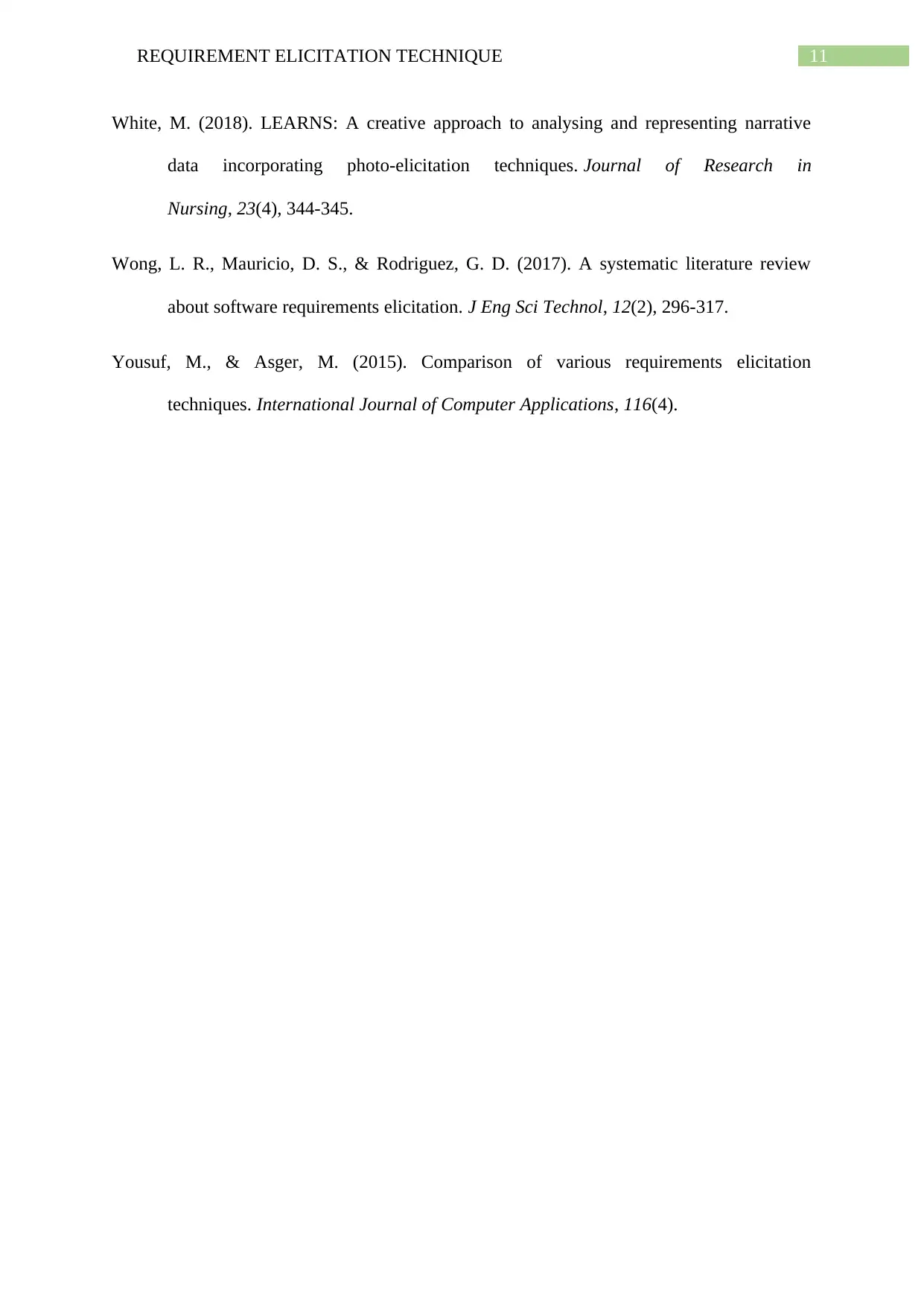
11REQUIREMENT ELICITATION TECHNIQUE
White, M. (2018). LEARNS: A creative approach to analysing and representing narrative
data incorporating photo-elicitation techniques. Journal of Research in
Nursing, 23(4), 344-345.
Wong, L. R., Mauricio, D. S., & Rodriguez, G. D. (2017). A systematic literature review
about software requirements elicitation. J Eng Sci Technol, 12(2), 296-317.
Yousuf, M., & Asger, M. (2015). Comparison of various requirements elicitation
techniques. International Journal of Computer Applications, 116(4).
White, M. (2018). LEARNS: A creative approach to analysing and representing narrative
data incorporating photo-elicitation techniques. Journal of Research in
Nursing, 23(4), 344-345.
Wong, L. R., Mauricio, D. S., & Rodriguez, G. D. (2017). A systematic literature review
about software requirements elicitation. J Eng Sci Technol, 12(2), 296-317.
Yousuf, M., & Asger, M. (2015). Comparison of various requirements elicitation
techniques. International Journal of Computer Applications, 116(4).
⊘ This is a preview!⊘
Do you want full access?
Subscribe today to unlock all pages.

Trusted by 1+ million students worldwide
1 out of 12
Related Documents
Your All-in-One AI-Powered Toolkit for Academic Success.
+13062052269
info@desklib.com
Available 24*7 on WhatsApp / Email
![[object Object]](/_next/static/media/star-bottom.7253800d.svg)
Unlock your academic potential
Copyright © 2020–2025 A2Z Services. All Rights Reserved. Developed and managed by ZUCOL.





